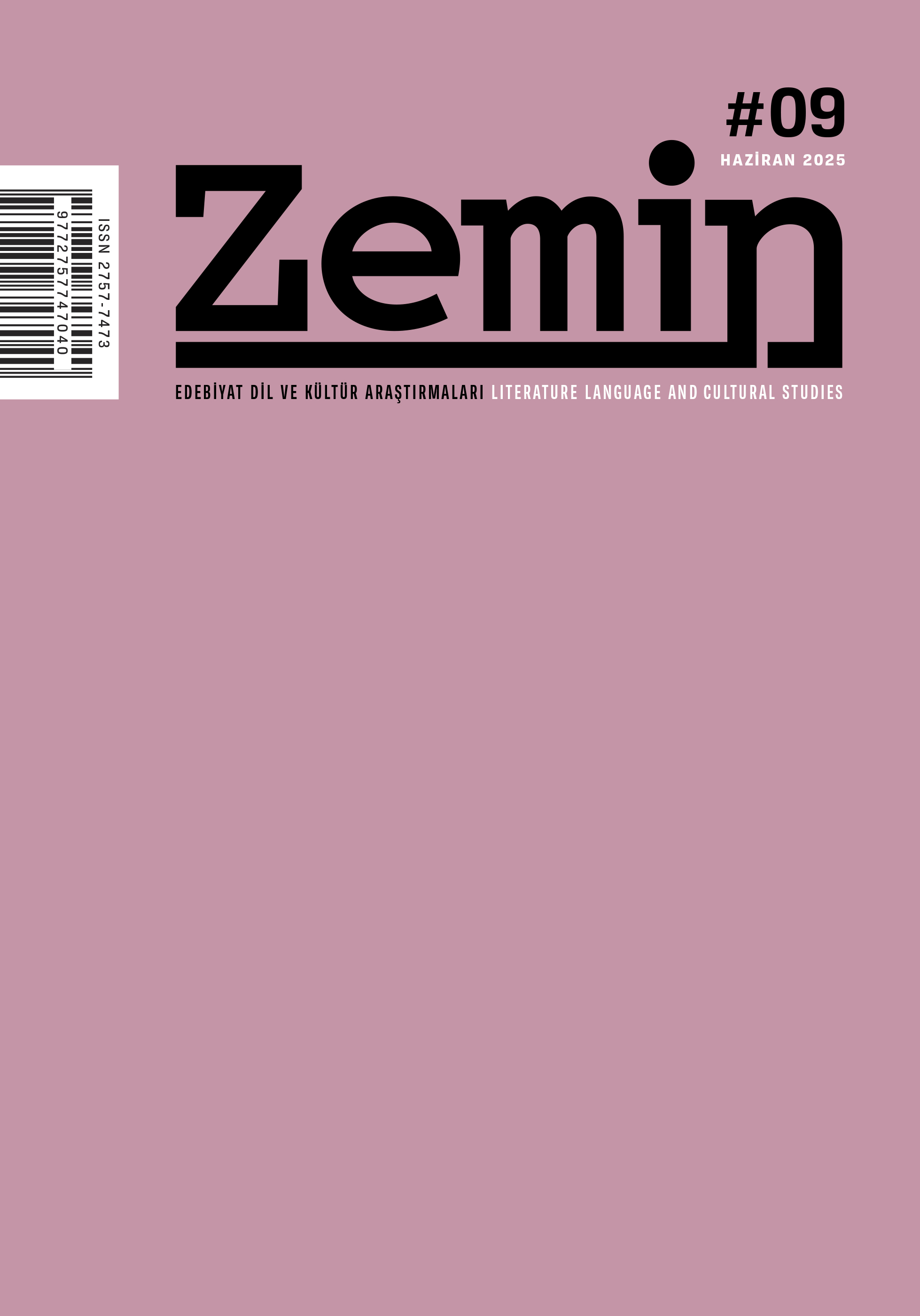A Folkloresque Novel: Ucunda Ölüm Var
DOI:
https://doi.org/10.5281/zenodo.15658077Keywords:
Ucunda Ölüm Var, Kemal Varol, lamentation, folkloresque, intertextuality, postmodernismAbstract
Kemal Varol, contemporary Turkish literature’s award-winning writer, carries the Anatolian tradition of lamentation to the fictional plane in his novel Ucunda Ölüm Var (Death Lies Ahead). In this novel, the diversity of stories enabled by the tradition of lamentation is transformed into a novel form. The tradition in question is evident both in the frame story of the novel and in its fictional structure. The novel presents all the rituals associated with the tradition in question. It allows for a folklore-oriented analysis that particularly focuses on the tradition of lamentation and its transformation into a novel form. Additionally, the lamentation rituals depicted in the novel provide the reader the opportunity to experience the tradition of lamentation within the reality of fiction. When examining the fields to which these intense folkloric elements correspond, the concept of the “folkloresque,” a term coined by Michael Dylan Foster and used in recent folklore studies, comes to the fore. Folkloresque refers to elements that evoke a sense of folklore, usually applied to consumer products of popular culture. Foster asserts that a folkloresque product should incorporate elements of “integration, portrayal, and parody.” In analyzing Ucunda Ölüm Var, it becomes evident that these elements are present in the novel. Regarding “integration,” Foster refers to the direct adaptation of a folkloric tradition to a different medium. Accordingly, the use of the tradition of lamentation as a form in Ucunda Ölüm Var fulfills this function. In the discussion of “portrayal,” he examines how folklorists are represented in popular culture products. However, this concept is open to extension and can encompass not only folklorists but also the practitioners of a tradition. Thus, the detailed portrayal of the Mourner Woman in the novel, which aligns with the tradition of lamentation, fulfills this function as well. Lastly, the discussion of “parody” addresses self-referential situations. In the novel, during the period of the lament performed for the Mourner Woman after her death, her soul laments for others, and this pattern shapes the main narrative structure of the text. The function of parody is thus revealed. In Ucunda Ölüm Var, the transformation of a folkloric tradition such as “lamentation” into a narrative form aligns with the intertextuality characteristic of postmodernism. In postmodern literature, intertextuality does not merely refer to one text referencing another. Within a perspective where everything is perceived as a text, the moment a reference is made to an external reality or imagination, the boundaries of intertextuality are entered. In terms of both taking a folkloric tradition as its theme and incorporating the narrative diversity offered by the possibilities of this tradition, Ucunda Ölüm Var is a type of intertextual novel. In this way, a tradition is reproduced in another context, allowing the recipient to experience folklore, and the structure called “folkloresque” is constructed with all its features. This study reveals how and to what extent the elements that constitute a folkloresque product appear in this novel.
References
Altay, Armağan. “Micheal Dylan Foster, Jeffrey A. Tolbert (ed.) Folkloreque. Boulder: Utah State University Yayınları, 2026, ISBN:978-1-60732-417-1, 265 sayfa.” Milllî Folklor, s. 30 (2018): 171-172.
Aktulum, Kubilay. Folklor ve Metinlerarasılık. İstanbul: Çizgi, 2022.
Başgöz, İlhan. “Ağıt, Sosyal Tarih ve Etnografya.” Somut Olmayan Kültürel Mirasın Müzelenmesi Sempozyumu Bildirileri, hazırlayanlar M. Öcal Oğuz ve Tuğba S. Özkan, 15-30. Ankara: Gazi Üniversitesi Türk Halkbilimi Araştırma ve Uygulama Merkezi, 2004.
Bauman, Richard. “Tür, Performans ve Metinler Arasılığın Üretimi.” Çeviren Işıl Altun. Halkbiliminde Kuramlar ve Yaklaşımlar, hazırlayanlar M. Öcal Oğuz, Selcan Gülçayır Teke ve Sunay Akkaya, 261-271. c. 3. Ankara: Geleneksel, 2015.
Bora, Tuğba. “Folklor Ürünlerinin Çağdaş Türk Edebiyatındaki Yansımaları: Yas Geleneği ve Ucunda Ölüm Var Romanı İlişkisi.” Uluslararası Altayistik Sempozyumu Bildiriler Kitabı, hazırlayanlar Gökçe Yükselen Peler ve Saffet Alp Yılmaz, 395-404. Ankara: Bengü, 2023.
Boratav, Pertev Naili. “Türk Ağıtlarının İşlevleri, Konuları ve Biçimleri.” Folklor ve Edebiyat, 458-467. c. 2. Ankara: BilgeSu, 2017.
Dorst, John D. “Postmodernizm ve Folklor.” Çeviren Serpil Cengiz. Halkbiliminde Kuramlar ve Yaklaşımlar, hazırlayanlar M. Öcal Oğuz, Metin Ekici, Nebi Özdemir, Gülin Öğüt Eker ve Selcan Gürçayır Teke, 63-65. c. 1. Ankara: Geleneksel, 2006.
Elçin, Şükrü. Türkiye Türkçesinde Ağıtlar. Ankara: Kültür Bakanlığı, 1990.
Ecevit, Yıldız. Türk Romanında Postmodernist Açılımlar. İstanbul: Everest, 2021.
Foster, Micheal Dylan. “Introduction: The Challenge of the Folkloreque.” The Folkoloresque: Reframing Folklore in a Popular Culture World, edited by Micheal Dylan Foster and Jeffrey A. Tolbert, 3-33. Colorado: Utah State University, 2016.
Hacıgökmen, Mehmet Ali. “Türklerde Yas Âdeti Temelleri ve Sonuçları.” Prof. Nejat Göyünç Armağanı, hazırlayanlar Hasan Bahar, Mustafa Toker, M. Ali Hacıgökmen, H. Gül Küçükbezci, 393-421. Konya: Selçuk Üniversitesi Türkiyat Araştırmaları Enstitüsü, 2013.
Honko, Lauri. “Ağıtlar: Yeniden Yaratma, Yapı ve Tür Problemleri.” Çeviren İsmail Görkem. Halk Biliminde Kuramlar ve Yaklaşımlar, hazırlayanlar M. Öcal Oğuz, Metin Ekici, Nebi Özdemir, Gülin Öğüt Eker ve Selcan Gürçayır Teke, 92-99. c. 1. Ankara: Geleneksel, 2006.
Koçak, Orhan. “Aynadaki Kitap/Kitaptaki Ayna: Postmodern Anlatının Bazı Sorunları.” Defter, s. 17 (1991): 65-144.
Makal, Tahir Kutsi. Anadolu’da Ağıtçı Kadınlar. III. Milletlerarası Türk Folklor Kongresi Bildirileri, c. 2, Halk Edebiyatı, 245-250. Ankara: Feryal Matbaacılık, 1986.
Parmaksız, Mehmet Nuri. Türk Edebiyatında Ağıt Yakma Geleneği ve Ağıt-Destanlar. Ankara: Akçağ, 2010.
Smidchens, Guntis. “Folklorizmi Yeniden Değerlendirmek.” Çeviren Altuğ Yılmaz. Folklor/Edebiyat, s. 4 (2000): 81-100.
Tolbert, A. Jeffrey. “Introduction.” The Folkoloresque: Reframing Folklore in a Popular Culture World, edited by Micheal Dylan Foster and Jeffrey A. Tolbert, 123-124. Colorado: Utah State University, 2016.
Yaşar Kemal. Ağıtlar. İstanbul: YKY, 2023.
Varol, Kemal. “Ucunda Ölüm Var. İstanbul: İletişim, 2019.
Zümbül T. Tuğçe ve Nursen Geyik Değerli. “Şaman Giysileri Üzerindeki Desenler ve Semboller.” International Social Mentality and Research Thinkers Journal, s. 8 (2022): 2004-2017.
Downloads
Published
How to Cite
Issue
Section
License
Copyright (c) 2025 Elif Türker

This work is licensed under a Creative Commons Attribution 4.0 International License.



